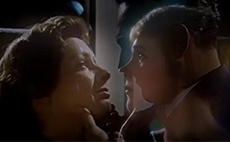Tecmerin. Journal of Audiovisual Essays
Monograph “Women in contemporary media”
Three Ways to Dine Well
Alison Peirse (University of Leeds) – 04:30
This essay film explores horror’s relationship to eating, in over seventy horror films made by women, from the 1920s–2020s.
Keywords: Horror Film, Women’s Film History, Feminist Film Historiography, Female Monsters, Women Filmmakers
L’unique. Maria Casarès
Carmen Ciller & Irene Azuaga (Universidad Carlos III de Madrid) – 04:30
The disturbing presence of the actress Maria Casarès in Orphèe (Jean Cocteau, 1950) brings us back to the gaze of the director who, from one shot to the next, captures her image for eternity. The verses by Lope de Vega, “This is love, whoever tried it knows it”, recorded by the actress, reinforce her image and her radical commitment to life, also linked to the soundtrack that bears her name “Maria Casarès”, which was recovered from the film Camus, the great love of his life.
Keywords: Actress, frame, gaze, shot, wardrobe
Deconstructing the Construction: The Female Images in Chinese Detective Films, 2010-2020
Ying-Hsiu Chou, University of Washington – 04:30
This audiovisual essay explores women in the most popular, influential Chinese detective films from 2010 to 2020. Centering critical feminist praxis to make an ethnographic inquiry into Chinese cinema through videographic criticism, it not only closely analyzes cinematic works across China, Hong Kong, Taiwan, and other Sinophone areas but also looks into their production and reception among Sinophone communities.
Keywords: Chinese cinema, detective genre, production, reception, representation, women
Philosophical Frameworks and Feminist Praxes in Lady Bird (Gerwig, 2017)
Rob Stone, University of Birmingham – 04:30
This trilogy of video essays analyses the film Lady Bird (2017), written and directed by Greta Gerwig, to clarify its philosophical meanings and feminist practices. Finding Jacques Derrida, Immanuel Kant and Luce Irigaray present, the resulting trilogy demonstrates how the participation of women in film can promote the subversion and realignment of existing norms and genre conventions.
Keywords: Gerwig, Feminism, Lady Bird, Philosophy, Self-determination
From One Shore to the Other
Valentín Vía Vázquez, Universidad Rovira i Virgili – 04:30
This audiovisual essay addresses the relationship between two spaces: the land and the sea. The land is separated by the sea, just in the same way the analyzed Ibero-American filmmakers are separated. The ocean unites them in a sea full of images where all these different relations come together on the shore. Apparently, it is a simple space: the shore.
Keywords: Documentary, Ibero-American, iconography, oceanic feeling, shore
Videoessays
Maria’s Marias
Maria Hofmann, University of Minnesota – 04:30
Maria’s Marias uses a multiscreen format to highlight the intercultural similarities and differences between the widely popular The Sound of Music (Wise, 1965) and its almost unknown German original, Die Trapp-Familie (Liebeneier, 1956). For many non-Austrians, the pure mother figure at the story’s core, Maria von Trapp, is the epitome of Austrian culture. In direct comparison, the representation of Maria and her transition from one prison to the next (from the abbey to the mansion and, finally, marriage) becomes apparent. This video essay aims to highlight the intertextual relationship between the Marias (including the original real person) and challenges their portrayal as the pure woman devoid of desires outside of marriage and motherhood.
Keywords: Austria, femininity, intertextuality, post-war cinema
Audiovisual Consumption in the 21st Century: Critical Factors in Scientific Dissemination
Almudena Muñoz Gallego, Universidad Complutense de Madrid & Suelayne Cris M. de Sousa, Universidad Federal de Río Grande del Norte – 04:30
In this audiovisual essay, we are exploring factors that make science a difficult subject in the media; more specifically, why audiovisual scientific dissemination does not have a relevant space in the media and, finally, what is the commitment of scientists, journalists, and content creators to this communication problem.
Keywords: Audiovisual, communication, discourse, dissemination, science
The Matter that Composes Your Memory. An Essay on Intimacy, Media and Remembrance
Víctor Santos López, Universitat Pompeu Fabra – 04:30
The matter that composes your memory shows a material intervention on the film stock which activates memory, time and intimacy.
Keywords: structural film, home movies, matter, memory
From the Archive
Notes on the feminist interventions in the Archive based on The Emerging Woman (Women’s Film Project, 1974)
With The Emerging Woman, Solberg wanted to make a didactic film that would explain the origins and nature of the vibrant women’s liberation movement, its strength and organisational capacity (Burton, 1986). The film, which is barely 40 minutes long, is notable for its multifaceted historical approach that is attentive to the links between the abolition of slavery and women’s political organisation; its intersectional look, also considering race and social class; and its analysis of oppressive femininities and their discourses.
Elena Oroz (UC3M)
Tecmerin. Journal of Audiovisual Essays
ISSN: 2659-4269
© Tecmerin Research Group
Universidad Carlos III de Madrid














